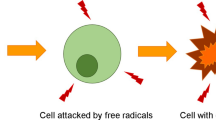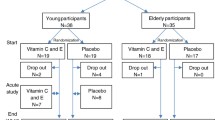Abstract
It has been widely noted that vitamin E shows numerous beneficial effects through and beyond its antioxidative properties; consequently, vitamin E is expected to prevent degenerative diseases. In the field of sports medicine, many studies dealing with vitamin E have been conducted originally from the point of view of its effects on physical performance. Although some earlier studies indicated that vitamin E supplementation could improve physical performance, defects in the study design or statistical analysis were pointed out at a later time. The majority of subsequent well controlled studies have reported no significant effect on physical performance from vitamin E supplementation. Recent studies suggest that endurance exercise may promote free radical generation in the body, and vitamin E may play an important role in preventing the free radical damage associated with endurance exercise. Although there is evidence of free radical involvement in exercise-induced muscle injury, vitamin E supplementation might not be expected to prevent muscle damage caused by exercise in humans without a vitamin E deficiency. Since it is still unclear whether exercise induces lipid peroxidation in the human body, the beneficial effect of vitamin E supplementation on exercise-induced lipid peroxidation has not yet been established. However, it is proposed that as a result of exercise vitamin E may be mobilised from store tissues and redistributed in the body to prevent oxidative damage. Therefore, we are convinced that vitamin E contributes to preventing exercise-induced lipid peroxidation. It has also been indicated that strenuous endurance exercise may enhance the production of oxidised low density lipoprotein (LDL), which plays a key role in the initiation and progression of atherosclerosis. It is also suggested that this enhanced production of oxidised LDL could be reduced if a higher vitamin E status is maintained. Supplementation with 100 to 200mg of vitamin E daily can be recommended for all endurance athletes to prevent exercise-induced oxidative damage and to reap the full health benefits of exercise.
Similar content being viewed by others
References
Stampfer MJ, Hennekens CH, Manson JE, et al. Vitamin E consumption and the risk of coronary disease in women. N Engl J Med 1993; 328 (20): 1444–9
Rimm EB, Stempfer MJ, Ascherio A, et al. Vitamin E consumption and the risk of coronary heart disease in men. N Engl J Med 1993; 328 (20): 1450–6
Shephard RJ. Vitamin E and athletic performance. J Sports Med 1983; 23: 461–70
Cureton TK. Effect of wheat germ oil and vitamin E on normal human subjects in physical training programs [abstract]. Am J Physiol 1954; 179: 628
Sharman IM, Down MG, Norgan NG. The effects of vitamin E on physiological function and athletic performance of trained swimmers. J Sports Med Phys Fitness 1976; 16 (3): 215–25
Shephard RJ, Campbell R, Pimm P, et al. Vitamin E, exercise, and the recovery from physical activity. Eur J Appl Physiol 1974; 33: 119–26
Watt T, Romet TT, McFarlane I, et al. Vitamin E and oxygen consumption. Lancet 1974; II (876): 354–5
Lawrence JD, Bower RC, Riehl WP, et al. Effect of alpha-to-copherol acetate on the swimming endurance of trained swimmers. Am J Clin Nutr 1975; 28: 205–8
Rokitzki L, Logemann E, Huber G, et al. α-Tocopherol supplementation in racing cyclists during extreme endurance training. Int J Sport Nutr 1994; 4: 253–64
Nielsen AN, Mizuno M, Ratkevicius A, et al. No effect of antioxidant supplementation in triathletes on maximal oxygen uptake, 31P-NMRS detected muscle energy metabolism and muscle fatigue. Int J Sports Med 1999; 20 (3): 154–8
Kobayashi Y. Effect of vitamin E on aerobic work performance in man during acute exposure to hypoxic hypoxia [dissertation]. Albuquerque (NM): University of New Mexico, 1974
Simon-Schnass I, Pabst H. Influence of vitamin E on physical performance. Int J Vitam Nutr Res 1988; 58: 49–54
Fritsma GA. Vitamin E and autoxidation. Am J Med Technol 1983; 49: 453–6
Astrand PO, Rodahl K.Textbook of work physiology. NewYork (NY): McGraw Hill, 1986
Cohen G, Heikkila R. The generation of hydrogen peroxide, superoxide and hydroxyl radical by 6-hydroxydopamine dialuric acid and related cytotoxic agents. J Biol Chem 1974; 249: 2447–50
Demopoulos HB, Santomier JP, Seligman ML, et al. Free radical pathology: rationale and toxicology of antioxidants and other supplements in sports medicine and exercise science. In: Katch FI, editor. Sport, health and nutrition. Champaign (IL): Human Kinetics Publishers, 1986: 139–89
Mista HL, Fridovich I. The generation of superoxide radical during the autoxidation of hemoglobin. J Biol Chem 1972; 247: 6960–4
Merry P, Kidd BL, Claxson A, et al. Synovitis of the joint is an example of reperfusion injury. In: Beaumont PC, Kidd BL, Claxson A, et al., editors. Free radicals, metal ions and biopolymers. London: Richelieu Press, 1989: 199–215
Tidball JG. Inflammatory cell response to acute muscle injury. Med Sci Sports Exerc 1995; 27 (7): 1022–32
Horwitt MK. Interpretations of requirements for thiamin, riboflavin, niacin-tryptophan, and vitamin E plus comments on balance studies and vitamin B6. Am J Clin Nutr 1986; 44: 973–85
Van Gossum A, Kurian R, Whitwell J, et al. Decrease in lipid peroxidation measured by breath pentane output in normals after oral supplementation with vitamin E. Clin Nutr 1988; 7: 53–7
Tiidus PM, Houston ME. Vitamin E status and response to exercise training. Sports Med 1995; 20: 12–23
Zerba E, Komorowski TE, Faulkner JA. Free radical injury to skeletal muscles of young, adult, and old mice. Am J Physiol 1990; 258: C429–35
Sumida S, Yanaka K, Kitao H, et al. Exercise-induced lipid peroxidation and leakage of enzymes before and after vitamin E supplementation. Int J Biochem 1989; 21: 835–8
Cannon JG, Orencole SF, Fielding RA, et al. Acute phase response to exercise: interaction of age and vitamin E on neutrophils and muscle enzyme release. Am J Physiol 1990; 259:R1214–9
Rokitzki L, Logemann E, Sagredos AN, et al. Lipid peroxidation and antioxidative vitamins under extreme endurance stress. Acta Physiol Scand 1994; 151: 149–58
Helgheim I, Hetland O, Nilsson S, et al. The effects of vitamin E on serum enzyme levels following heavy exercise. Eur J Appl Physiol 1979; 40: 283–9
Francis KT, Hoobler T. Failure of vitamin E and delayed muscle soreness. Alabama Med 1986; 55: 15–8
Kanter MM, Eddy DE. Effect of antioxidant supplementation on serum markers of lipid peroxidation and skeletal muscle damage following eccentric exercise [abstract]. Med Sci Sports Exerc 1992; 24: S17
Robertson JD, Crosbie L, Maughan RJ, et al. Influence of vitamin E supplementation on muscle damage following endurance exercise. Int J Vitam Nutr Res 1990; 60: 171–2
Jenkins RR. Exercise, oxidative stress, and antioxidants: a review. Int J Sport Nutr 1993; 3: 356–75
Tiidus PM. Can estrogens diminish exercise induced muscle damage? Can J Appl Physiol 1995; 20 (1): 26–38
Horvat RJ, Lane WG, Ng H, et al. Saturated hydrocarbons from autoxidizing methyl linoleate. Nature 1964; 203: 523–4
Dillard CJ, Litov RE, Savin WM, et al. Effects of exercise, vitamin E, and ozone on pulmonary function and lipid peroxidation. J Appl Physiol 1978; 45 (6): 927–32
Halliwell B, Gutteridge JMC. Measurement of lipid peroxidation. In: Halliwell B, Gutteridge JMC, editors. Free radicals in biology and medicine. Oxford: Clarendon Press, 1985: 161–70
Kojima T, Kikugawa K, Kosugi H. Is the thiobarbituric acid reactivity of blood plasma specific to lipid peroxidation? Chem Pharm Bull 1990; 38 (12): 3414–8
Kanter MM, Lesmes GR, Kaminsky LA, et al. Serum creatine kinase and lactate dehydrogenase changes following an eighty kilometer race. Eur J Appl Physiol 1988; 57: 60–3
Kanter MM, Nolte LA, Holloszy JO. Effects of an antioxidant vitamin mixture on lipid peroxidation at rest and post exercise. J Appl Physiol 1993; 74 (2): 965–9
Viinikka L, Vuori J, Ylikorkala O. Lipid peroxides, prostacyclin, and thromboxane A2 in runners during acute exercise. Med Sci Sports Exerc 1984; 16 (3): 275–7
Duthie GG, Robertson JD, Maughan RJ, et al. Blood antioxidant status and erythrocyte lipid peroxidation following distance running. Arch Biochem Biophys 1990; 282 (1): 78–83
Surmen-Gur E, Ozturk E, Gur H, et al. Effect of vitamin E supplementation on post-exercise plasma lipid peroxidation and blood antioxidant status in smokers: with special reference to haemoconcentration effect. Eur J Appl Physiol 1999; 79: 472–8
Lovlin R, Cottle W, Pyke I, et al. Are indices of free radical damage related to exercise intensity? Eur J Appl Physiol 1987; 56: 313–6
Takanami Y, Iwane H, Kawai Y, et al. Strenuous endurance exercise decreases the products of lipid peroxidation in serum [abstract]. Med Sci Sports Exerc 1995; 27 (5): S69
Meydani M, Evans WJ, Handelman G, et al. Protective effect of vitamin E on exercise-induced oxidative damage in young and older adults. Am J Physiol 1993; 264: R992–8
Kawai Y, Iwane H, Takanami Y, et al. Vitamin E is mobilized in relation to lipolysis after strenuous endurance exercise [abstract]. Med Sci Sports Exerc 1994; 26 (5): S7
Kawai Y, Iwane H, Takanami Y, et al. Mechanisms of the increase in serum vitamin E level through strenuous endurance exercise [abstract]. Med Sci Sports Exerc 1995; 27 (5): S9
Pincemail J, Deby C, Camus G, et al. Tocopherol mobilization during intensive exercise. Eur J Appl Physiol 1988; 57: 189–91
Sánchez-Quesada JL, Homs-Serradesanferm R, Serrat-Serrat J, et al. Increase of LDL susceptibility to oxidation occurring after intense, long duration aerobic exercise. Atherosclerosis 1995; 118 (2): 297–305
Sánchez-Quesada JL, Ortega H, Payes-Romero A, et al. LDL from aerobically-trained subjects shows higher resistance to oxidative modification than LDL from sedentary subjects. Atherosclerosis 1997; 132 (2): 207–13
Vasankari TJ, Kujala UM, Vasankari TM, et al. Increased serum and low-density-lipoprotein antioxidant potential after antioxidant supplementation in endurance athletes. Am J Clin Nutr 1997; 65 (4): 1052–6
Itabe H, Yamamoto H, Imanaka T, et al. Sensitive detection of oxidatively modified low density lipoprotein using a monoclonal antibody. J Lipid Res 1996; 37: 45–53
Takanami Y, Shimomitsu T, Kawai Y, et al. Can exercise enhance the production of oxidized LDL in plasma [abstract]? Med Sci Sports Exerc 1999; 31 (5): S109
Takanami Y, Iwane H, Kawai Y, et al. Vitamin E supplementation prevents low density lipoprotein from oxidative modification induced by maximal exercise [abstract]. Med Sci Sports Exerc 1994; 26 (5): S7
Inoue T, Mu Z, Sumikawa K, et al. Effect of physical exercise on the content of 8-hydroxydeoxyguanosine in nuclear DNA prepared from human lymphocytes. Jpn J Cancer Res 1993; 84: 720–5
Asami S, Hirano T, Yamaguchi R, et al. Reduction of 8- hydroxyguanine in human leukocyte DNA by physical exercise. Free Radic Res 1998; 29 (6): 581–4
Hartmann A, Niess AN, Grunert-Fuchs M, et al. Vitamin E prevents exercise-induced DNA damage. Mutat Res 1995; 346: 195–202
Witt EH, Reznick AZ, Viguie CA, et al. Exercise, oxidative damage and effects of antioxidant manipulation. J Nutr 1992; 122: 766–73
Davies KJA, Quintanilha AT, Brooks GA, et al. Free radicals and tissue damage produced by exercise. Biochem Biophys Res Commun 1982; 107 (4): 1198–205
Packer L, Reznick AZ, Simon-Schnass I, et al. Significance of vitamin E for the athlete. In: Fuchs J, Packer L, editors. Vitamin E in health and disease. New York (NY): Marcel Dekker, 1992: 465–71
Kawai Y, Katsumura T, Takanami Y, et al. The effect of prolonged exercise on the formation of oxidized LDL and total antioxidant capacity in serum [in Japanese]. Descente Sports Sci 1998; 19: 229–38
Acknowledgements
The authors would like to express their sincere gratitude to the late Professor Hisao Iwane, formerly of the Department of Preventive Medicine and Public Health, Tokyo Medical University, for his great contributions to this review. The authors would also like to extend their thanks to Patrick J. Dwyer for his assistance in the preparation of this manuscript.
Author information
Authors and Affiliations
Corresponding author
Rights and permissions
About this article
Cite this article
Takanami, Y., Iwane, H., Kawai, Y. et al. Vitamin E Supplementation and Endurance Exercise. Sports Med 29, 73–83 (2000). https://doi.org/10.2165/00007256-200029020-00001
Published:
Issue Date:
DOI: https://doi.org/10.2165/00007256-200029020-00001




